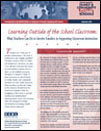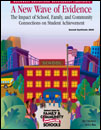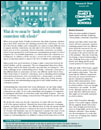Search Results: Related Resources
Afterschool; Family and Community; SEDL Letter, Volume XX, Number 2 (Aug. 2008): Afterschool, Family, and Community (2008)
SEDL Letter, Volume XX, Number 2 (Aug. 2008): Afterschool, Family, and Community (2008)This issue of SEDL Letter is devoted to topics centered around afterschool and family and community involvement, with a focus on what the latest research shows. |
English Language Learners; Family and Community; Stepping Stones: A Texas Migrant Early Childhood Program for 3- and 4-Year-Olds (2012)
Stepping Stones: A Texas Migrant Early Childhood Program for 3- and 4-Year-Olds (2012)This home-based migrant preschool program provides 100 lessons aligned to the Revised Texas Prekindergarten Guidelines. The lessons, available in both English and Spanish, are organized around early learning themes or units. A manual to guide home educators and migrant program coordinators is included. |
Family and Community; Reaching Out to Diverse Populations: What Can Schools Do to Foster Family-School Connections? (2005)
Reaching Out to Diverse Populations: What Can Schools Do to Foster Family-School Connections? (2005)This strategy brief includes strategies schools can use to promote involvement of families from diverse cultural backgrounds. |
 SEDL Insights, Vol. 2, No. 2: How Districts Can Lay the Groundwork for Lasting Family Engagement (2014)
SEDL Insights, Vol. 2, No. 2: How Districts Can Lay the Groundwork for Lasting Family Engagement (2014)Family engagement in a student’s education can lead to improved student academic achievement, attendance, and behavior. Yet many districts and schools still struggle to form strong partnerships with the families they serve. Having a supportive district-level infrastructure is key to the success and sustainability of family engagement initiatives. |
 Partners in Education: A Dual Capacity-Building Framework for Family–School Partnerships (2014)
Partners in Education: A Dual Capacity-Building Framework for Family–School Partnerships (2014)This resource presents a new framework for designing family engagement initiatives that build capacity among educators and families to partner with one another around student success. Based in existing research and best practices, this report is designed to act as a scaffold for the development of family engagement strategies, policies, and programs. |
 Improving Family and Community Engagement Through Sharing Data: Southeast Comprehensive Center Briefing Paper, November 2012 (2012)
Improving Family and Community Engagement Through Sharing Data: Southeast Comprehensive Center Briefing Paper, November 2012 (2012)As data collection, analysis, and decision making expand on state and local levels, so does the expectation of effectively communicating data to the families of school children and their communities. Surveys indicate that people value receiving information on their schools (Owens & Peltier, 2002). They want to know how their schools are doing and are interested in receiving more detailed information (Owens & Peltier). |
 Teenage Parents and Their Educational Attainment: Texas Comprehensive Center Briefing Paper, Number 5 (2011)
Teenage Parents and Their Educational Attainment: Texas Comprehensive Center Briefing Paper, Number 5 (2011)Becoming a parent, at any age, can be a life-altering experience. Regardless of race, education, and socio-economic status, motherhood—and fatherhood—uniformly places demands on one’s life that were non-existent prior to the birth of a child. When school-aged students become parents, the new responsibilities can be overwhelming. For teenage parents who lack support from their own parents, this experience can be even more daunting as they seek support in adult-oriented systems, which even older parents may find challenging. |
 Working Systemically in Action: Engaging Family & Community (2010)
Working Systemically in Action: Engaging Family & Community (2010)Many educators recognize the importance of family and community involvement in school improvement efforts and are seeking to reframe the way they engage these groups. This publication, which supplements Working Systemically in Action: A Facilitator’s Guide (No longer available, as the publication has been replaced by the book, Getting Serious About the System), provides practical guidance for educators who are seeking to engage family and community members in systemic school improvement efforts. 
|
 Parent and Community Involvement in a College/Career–Ready Culture: Texas Comprehensive Center Briefing Paper, Number 2 (2010)
Parent and Community Involvement in a College/Career–Ready Culture: Texas Comprehensive Center Briefing Paper, Number 2 (2010)This brief addresses the questions: What are some examples of underachieving schools that have involved parents and community partners to increase student achievement through building a focus on college and career readiness? How do they solicit community response and what contributions have parents/community members made to support a college and career readiness environment? What does the research say about this topic? |
 A Toolkit for Title I Parental Involvement (2009)
A Toolkit for Title I Parental Involvement (2009)Designed for educators who are implementing Title I, Part A parental involvement provisions, this toolkit includes detailed explanations of the provisions and 33 tools to help states, districts, and schools meet the requirements. |
 The School-Family Connection: Looking at the Larger Picture, A Review of Current Literature (2008)
The School-Family Connection: Looking at the Larger Picture, A Review of Current Literature (2008)This review of family involvement literature published from 2005 to 2008 explores a range of family involvement programs, challenges, needs, strategies, and contexts. |
 Beyond the Building: A Facilitation Guide for School, Family, and Community Connections (2006)
Beyond the Building: A Facilitation Guide for School, Family, and Community Connections (2006)This multimedia toolkit will help educators and community organizers understand and learn how to facilitate family and community involvement. |
 Easing the Transition from PreK to Kindergarten: What Schools and Families Can Do to Address Child Readiness (2005)
Easing the Transition from PreK to Kindergarten: What Schools and Families Can Do to Address Child Readiness (2005)This strategy brief discusses the importance of school-family connections in ensuring a successful transition from PreK to Kindergarten. |
 Creating Collaborative Action Teams: Working Together for Student Success (2000)
Creating Collaborative Action Teams: Working Together for Student Success (2000)This multi-media kit is a set of concepts, activities, and resources that individuals, school districts and other organizations can use to develop a partnership between home, school, community, and students at the local level. |
 Organizing Family and Community Connections With Schools: How Do School Staff Build Meaningful Relationships With All Stakeholders? (2005)
Organizing Family and Community Connections With Schools: How Do School Staff Build Meaningful Relationships With All Stakeholders? (2005)This strategy brief examines proactive strategies schools can use to help them build strong relationships with family and community. |
 Engaging Families at the Secondary Level: What Schools Can Do to Support Family Involvement (2005)
Engaging Families at the Secondary Level: What Schools Can Do to Support Family Involvement (2005)This strategy brief discusses strategies for successful family involvement at the middle school and high school levels. |
 Developing a Collaborative Team Approach to Support Family and Community Connections With Schools: What Can School Leaders Do? (2005)
Developing a Collaborative Team Approach to Support Family and Community Connections With Schools: What Can School Leaders Do? (2005)This strategy brief includes ideas for involving families actively in the decision-making and implementation efforts needed for school improvement. |
 Learning Outside of the School Classroom: What Teachers Can Do to Involve Family in Supporting Classroom Instruction (2004)
Learning Outside of the School Classroom: What Teachers Can Do to Involve Family in Supporting Classroom Instruction (2004)This strategy brief was produced by SEDL's National Center for Family and Community Connections with Schools, part of SEDL's Regional Educational Laboratory contract. The Center links people with research-based information and resources that they can use to effectively connect schools, families, and communities. |
 Readiness: School, Family, & Community Connections (2004)
Readiness: School, Family, & Community Connections (2004)The fourth research synthesis focusing on family and community connections with schools describes 48 research studies on the contextual factors associated with children's school readiness. |
 Diversity: School, Family, and Community Connections (2003)
Diversity: School, Family, and Community Connections (2003)SEDL's third research synthesis in a series on family and community connections with schools focuses on race/ethnicity, culture (including language), and socioeconomic status. |
 A New Wave of Evidence: The Impact of School, Family, and Community Connections on Student Achievement (2002)
A New Wave of Evidence: The Impact of School, Family, and Community Connections on Student Achievement (2002)This review of the research examines the growing evidence that family and community connections with schools make a difference in student success. |
 What Do We Mean by "Family and Community Connections with Schools?" (2002)
What Do We Mean by "Family and Community Connections with Schools?" (2002)This strategy brief was produced by SEDL's National Center for Family and Community Connections with Schools, part of SEDL's Regional Educational Laboratory contract. The Center links people with research-based information and resources that they can use to effectively connect schools, families, and communities. |
 Emerging Issues in School, Family, & Community Connections (2001)
Emerging Issues in School, Family, & Community Connections (2001)This research synthesis highlights critical areas of work in family and community connections with schools where clarification, agreement, and further development are needed. |
 Family and Community Involvement: Reaching Out to Diverse Populations (2000)
Family and Community Involvement: Reaching Out to Diverse Populations (2000)This book is geared toward teachers, principals, and superintendents who want to develop meaningful parent and community involvement in culturally and linguistically diverse communities. |
 Building Support for Better Schools: Seven Steps to Engaging Hard-to-Reach Communities (2000)
Building Support for Better Schools: Seven Steps to Engaging Hard-to-Reach Communities (2000)This practical guide is designed for educators, civic leaders, community organizers or anyone else interested in involving traditionally hard-to-reach communities. |
